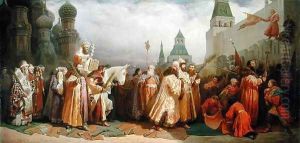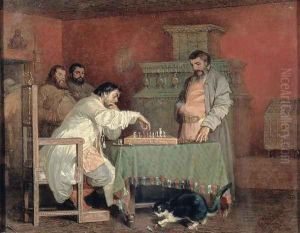Viatcheslav Grigorievitch Schwarz Paintings
Viatcheslav Grigorievitch Schwarz, also known as Slavomir Schwarz, was a Russian painter born on May 14, 1838, in Yelabuga, which at the time was part of the Russian Empire. His father was Grigory Ivanovich Schwarz, a civil engineer, which provided Viatcheslav with a relatively comfortable upbringing. His initial education was not particularly focused on the arts; however, his talent became apparent early in his life.
Schwarz's artistic journey began in earnest when he moved to Saint Petersburg. In 1855, he enrolled in the Imperial Academy of Arts, which was the premier institution for the arts in Russia during that period. Under the tutelage of renowned artists such as Pyotr Basin and Bogdan Villevalde, Schwarz honed his skills in painting. He was particularly interested in historical and religious themes, which were popular and well-regarded subjects within the Russian art community of the time.
During his time at the Academy, Schwarz was recognized for his talent and was awarded several medals for his work, including a silver medal in 1858. His graduation piece, 'The Return of the Shuisky to Moscow', received a gold medal and granted him the title of class artist of the first degree in 1861. Following his formal education, Schwarz embarked on a trip abroad, a common practice for artists of the era to complete their studies and gain broader exposure to European art and culture.
His travels took him to Germany, Switzerland, and Italy, where he was particularly influenced by the works of the old masters. Despite his exposure to various styles, Schwarz remained dedicated to the academic principles he had learned in Saint Petersburg, emphasizing classical composition, clarity, and historical accuracy in his work.
Tragically, Viatcheslav Grigorievitch Schwarz's life and career were cut short when he died from tuberculosis on December 30, 1869, at the young age of 31. Despite his brief career, Schwarz left behind a legacy that included religious and historical paintings that were praised for their technical skill and emotional depth. His works can be found in various Russian museums, including the Tretyakov Gallery, where they continue to be appreciated by art lovers and historians alike.

